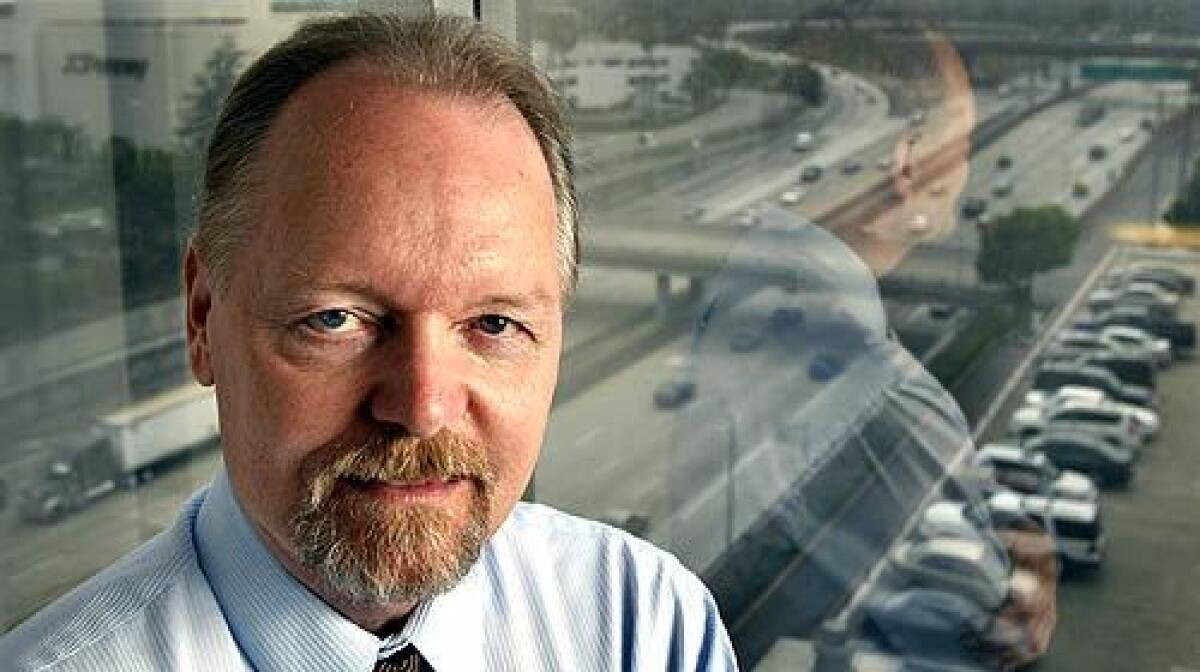Think Southern California’s freeways are jammed? You should see the calendars of upcoming road work

- Share via
Inside Tom W. Bogard’s office, maps are everywhere. They help the highway director for the Orange County Transportation Authority see the future -- or at least where the next caution signs for construction will be posted.
Over the next five years, Bogard and his counterparts in neighboring counties will act as railroad yardmasters, coordinating projects to relieve congestion so they are spaced apart and done mostly at night, so commuters can avoid delays.
“Work is underway for $2 billion in projects in Orange County,” Bogard said. For freeway engineers, planning analysts and environmental firms, that’s the equivalent of the gun going off in an Oklahoma land rush.
San Diego, Riverside and Orange counties, in partnership with the California Department of Transportation, have such busy calendars for freeway work, including interchanges and widenings, that experts say the boom is enough to bump up the sluggish construction economy.
Because of its size, Los Angeles County hopes to spend $150 billion over the next two decades on an ambitious agenda that includes dozens of highway and transit projects, including rail extensions such as the Gold Line into San Gabriel Valley. The Metropolitan Transportation Authority relies on two tax measures and is studying whether to have voters approve a third sales tax. Despite the ambitious agenda, more than a dozen projects are not funded, said MTA spokesman Marc Littman.
In Orange County, the last time the drawing board for freeways was so crowded was in the late 1980s. This year’s schedule has five projects, including revamped interchanges and widening, on the 5 and 22 freeways.
Orange County transit authorities want to tap into the funds expected to flow from a renewed sales tax, saving money on escalating construction and materials costs.
That’s set off a planning binge, begun after OCTA sold up to $400 million in commercial paper to kick-start projects. San Diego and Riverside have taken similar steps, prompting OCTA to pay for a study to determine whether construction and engineering firms here can handle the extra load and whether enough are available for projects.
Bogard’s maps show that over the next three years, widening and interchange work will begin on the congested 91 and 57 freeways in northern Orange County and I-5 in the south, where new interchanges at Avenida Pico and Ortega Highway are being planned.
In another month, environmental work will begin on the 405 Freeway, which will be widened by two lanes in each direction along a 13-mile stretch from Costa Mesa to Long Beach.
Riverside County, which anticipates $2 billion in public works improvements over the next 10 years, sold $130 million in commercial paper with the intent to improve the 91 Freeway. San Diego, which wants to unclog congested corridors in North County, borrowed $500 million against future tax revenue.
“Construction costs were rising 2% to 3% a year, but in the last several years, we were getting into the double digits,” said Jack Boda, mobility director for the San Diego Assn. of Governments.
The strategy to borrow against future tax revenue is sound, Boda said, because it helps road-building agencies take advantage of current planning and building costs, essentially discounting future work.
San Diego County’s proposals include improvements to I-5, I-15 and a major widening of I-805, Boda said.
In Orange County, the first $25 million from the bond sale arrived last month, leading to the study to determine whether there are enough firms to handle the workload.
Wallace Walrod, vice president of research for the Orange County Business Council, which is doing the OCTA assessment, said there appeared to be enough design and construction firms to handle the business. “Part of the optimism is the downturn in the economy has freed up capacity.
“If the economy had been roaring strong, there might have been larger hurdles,” he said.
In addition to freeways, OCTA has received state funds to start renovating eight railroad crossings, complete traffic signal synchronization and aid cities with road improvements.
All those projects are welcome news for design, construction and consultant firms large and small.
“We’re stretched thin, but on the other hand it’s a good time to grow, and Southern California has a lot of work expected,” said Maureen “Mo” Hayes, vice president of business development for Parsons Corp., an international engineering and construction firm.
H. Tony Rahimian, who owns RMC Inc., a transportation planning and design firm in Irvine, was on his own until nearly a year ago. Now the firm has 10 employees and has clients in Riverside, Los Angeles and Orange counties.
“When you look at the tax measures for the immediate five or six counties, excluding L.A., they total about $50 billion over the next 30 years, and that dollar amount isn’t going to go away,” Rahimian said.
“I believe this has been identified by most of us in the industry as a significant challenge. . . . The question is, can we sustain this growth,” he said.
More to Read
Sign up for Essential California
The most important California stories and recommendations in your inbox every morning.
You may occasionally receive promotional content from the Los Angeles Times.










